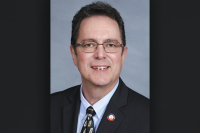Youth get a hands-on look at planning their future
By Jennifer Garlesky • Staff Writer
Rachel Upchurch wants to protect the mountains that tower throughout Jackson County however; the Smokey Mountain Elementary student also wants to see more houses and shopping centers built throughout the Qualla community.
Upchurch’s view of future development along U.S. 441 — a four-lane highway that runs from U.S. 74 junction to downtown Cherokee — is one of the responses that were given during a youth educational workshop at Smokey Mountain Elementary School on Jan. 15.
Students at Smokey Mountain Elementary and Cherokee Indian Reservation schools were given the opportunity to learn about land development at the educational workshop, which is part of Jackson County’s U.S. 441 corridor study.
County officials voted in October to conduct a study to protect this area’s rural landscape from over development. County officials are anticipating a surge of growth to occur along this four-mile corridor once the Whittier sewer plant reaches completion this summer.
Related Items
A Raleigh based consulting firm, Kimley-Horn and Associates, have been studying the corridor’s landscape and are developing a plan to regulate future development.
Getting the student’s involved in the workshop was part of a grant funded through the Cherokee Preservation Foundation. The foundation, which operates from gaming revenues generated at Harrah’s Cherokee Casino, awards grants to organizations that host projects that focuses on the preservation of the Eastern Band of Cherokee Indians culture.
Including the student’s point-of-view of how the land should be developed along the corridor is important to the study, said Kimley-Horn planner Stephen Stansbery.
The students are stakeholders in the study because they will be the future leaders of this area, Stansbery said.
When school officials announced that students could partake in the study, students like Upchurch decided to take advantage of this rare opportunity to contribute her thoughts about the county’s future.
“I wanted to give Jackson County a new idea of what they can do with our community,” said the seventh grader.
Fellow classmate Brittany Bullock shared a similar opinion about the educational workshop.
“It gives us a saying in what should happen,” she said.
The workshop
At the Smokey Mountain Elementary educational workshop, fourteen middle school students learned about land preservation and development. Students were taught a brief history lesson about land planning pioneers Frederick Law Olmsted — who designed the Biltmore and New York City’s Central Park — and John Nolan, a landscape architect who design the city of Asheville.
Students also participated in several hands on exercises. Students were showed 10 different slides that featured two pictures — the first showcased a sign of land development and the other was of a natural landscape. The exercise required the students to pick the photo that stood out the most to them.
The survey was to get students thinking about change and that they live in a special place that is worth protecting, Stansbery explained.
Additionally, the students also learned how the consulting firm uses computer programs to create 3-D images to help them predict what future development will look like in correlation with the mountain view shed.
In the final exercise the students were split into three groups. Each group received a large topographic map of the corridor study area and was asked to circle on the map what areas they would preserve and where they would allow commercial and residential development to occur.
Information gathered from the youth workshops will be incorporated into the public meeting on Jan. 23 and 24 at the Qualla Community Center where residents will be able to weigh in on the firm’s initial development plans for the corridor.
Stansbery says that it is important to incorporate the youth’s perception of the corridor into the study because it generates new ideas.
“There views are a different perspective,” he said. “It gets adults thinking because they (the students) are going to inherit the decisions the adults are making today.”









